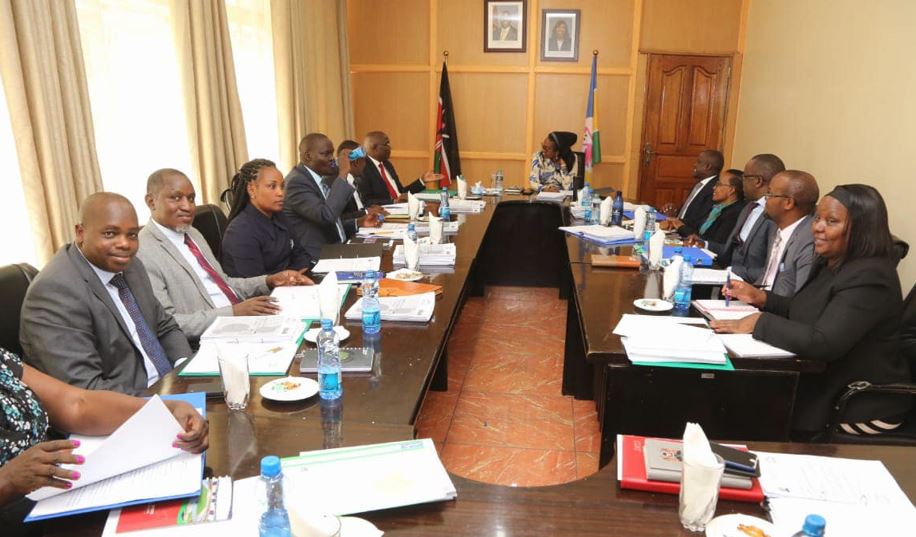The County Government of Nakuru has put measures in place to strengthen accountability and fiscal discipline in the use of its resources to deliver better services and enhance equitable economic development.
Governor Susan Kihika said her administration was enhancing own-source revenue (OSR) streams through the adoption of a cashless mode of payment, the installation of CCTVs in key revenue collection points, and deploying a vibrant and dynamic workforce.
While noting that Counties were collecting less revenue than their potential due to poor systems and leakages, Ms Kihika reiterated her Administration’s resolve to seal all the loopholes that interfere with the optimal use of the revenue generated.
Speaking after chairing a Cabinet meeting where the Nakuru County Finance Bill 2023 was approved, the Governor highlighted some of the revenue streams being enhanced, such as property tax, building permits, business licenses, liquor licenses, vehicle parking fees, and outdoor advertising.
“The Nakuru County Finance Bill 2023 is critical to the generation of own-source revenue (OSR). The county has not passed a Finance Bill since 2019. The Bill concentrates not on increasing levies, but on expanding the tax base,” stated the governor.
A tax Gap Impact Report by the Commission of Revenue Allocation (CRA) and the World Bank estimates that Nakuru misses out on an estimated Sh1.985 billion annually of its internal revenue potential.
Counties run on cash transfers from the national government and Own-Source Revenue (OSR) in the form of taxes, charges, loans, and grants.
Between 2013 and 2022, counties’ OSR was extremely low, accounting for less than 15 per cent of their budgets, implying overdependence on transfers from the national government.
According to the Commission on Revenue Allocation (CRA), in the financial year 2021–2022, the average revenue generated by all counties from their own sources was about one-third of their potential, which points to vast unexploited county revenue.
Governor Kihika affirmed that the County Government was determined to ensure transparency in all the County Government’s financial dealings, which she said will enhance the purpose of devolution by taking public finances closer to citizens in a manner that would allow them to have a say on how county budgets are planned for and used.
“We are committed to complying with the Constitution and the 2012 Public Finance Management Act (PFMA), which require each of Kenya’s 47 counties to publish information during the formulation, approval, implementation, and audit stages of the budget cycle. Nakuru County has competent and well-staffed financial management staff and systems.” Said Ms Kihika.
She further affirmed that she will ensure timely generation of both budget estimates and implementation documents so that citizens could hold the County Government financially accountable, adding that making documentation against which accountability can be gauged is a right of Kenyans.
The devolved units overrely on transfers of the equitable share of the revenue from the National Government to pay staff salaries and other daily costs that have come at the expense of development projects.
Delays in the release of equitable share, money shared between the national and county governments, have in the past nearly crippled critical services at the counties, such as hospitals, while in other cases county staff went for months without salaries.
The Governor, however, stated that the County Government was working on an Integrated County Revenue Management System, including digitizing land and property records, which she said was critical in enabling the County, to optimize its revenue potential.
Cuts in fiscal transfers to counties combined with population growth, time, and the value of money imply that county per capita spending will decline over the next two to three years unless counties own source revenue (OSR) performance is significantly enhanced to close the resource gap.
A report by CRA for the year ending June 2022 indicated that a majority of counties flouted the budgetary allocation limits. They also missed the target for Own-Source Revenue (OSR) collections, collectively netting Sh35.9 billion against the target of Sh60.4 billion for the fiscal year.
Only four county governments (Turkana, Migori, Lamu, and Vihiga) were able to collect more than one hundred percent of their annual OSR target in the fiscal year,” said the National Treasury in disclosures contained in the 2023 Draft Budget Policy Document.
These missed milestones, experts say, point to revenue mobilization weaknesses that are borne out of the fact that many counties do not have an economic base that can generate taxes, yet they have to provide a wide range of services to their residents.
A June 2022 study by the Commission on Revenue Allocation (CRA), estimated the revenue potential of county governments at Sh215.6 billion, which is six times the actual collection in the past fiscal year.
36 out of the 47 devolved units surpassed the 35 percent cap on wages and benefits spent in relation to revenue.
Of the 11 that met the wage cap threshold, the top performers were Tana River, Mandera, and Isiolo, at 28 percent of revenue.
Meanwhile, Machakos, Garissa, and Kisii counties spent the highest share of revenue paying workers at 62 per cent, 60 per cent and 58 per cent respectively.
Only 12 out of the 47 counties spent more than 30 per cent of their annual outlay on development programmes. Half of these 12 counties were also on the list of the 11 that kept their wage expenditure below the required limit.
In the approved budgets laid down at the beginning of the fiscal year, all but two counties (Nairobi and Kiambu) had allocated 30 per cent of expected expenditure to development, pointing to changes in expenditure priorities during the year due to funding shortfalls.
One of the ways being mooted to address the recurrent-development budget imbalance is for counties to make better use of the debt market, where they can issue bonds to support development projects.
By Esther Mwangi and Angela Cherotich





